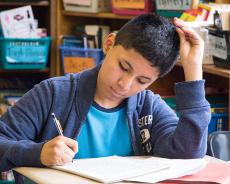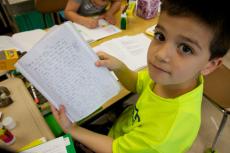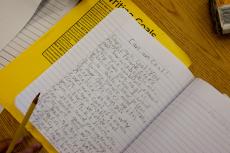Writing Assessments
Assessing students’ progress as writers of information, opinion/argument and narrative on-demand texts.
This October, Heinemann will release Writing Pathways, a book and collection of resources by Lucy Calkins with TCRWP colleagues (especially Audra Kirshbaum Robb and Kelly Boland Hohne).
This release brings the assessment system that undergirds standards-based writing workshop instruction to teachers everywhere. This assessment system is foundational to Units of Study in K-8 Opinion/Argument, Information and Narrative Writing—it has been adapted slightly for the new book release so that it is applicable to any classroom, whether or not it follows a workshop approach to teaching writing.
You are also invited to create your own homemade version of this assessment system, as there are extraordinary lessons to be learned from fashioning such a tool together in the company of your colleagues and whatever set of standards you adopt.
Essentially, this is the gist of our tool.
We ask K-8 teachers to launch the school year by saying, “Today, take one period and write your best…” and then we describe either narrative, information or argument writing in the simplest, clearest way possible. We don’t give specific topics, but instead leave that decision to students. “Write your best personal narrative, your best true story, telling the story of one small moment. Write this in a way that shows what you know how to do.” Teachers generally do this at the start of the year for all three kinds of writing.
Then, with involvement from the kids themselves, teachers score those pieces of writing against some tools we give them. The tools include leveled checklists that detail what the writing should look like to be on-grade-level for each grade, spelling out what the lead/introduction needs to do for the text to be at-grade-level for each of those kinds of writing, what the transitions need to be like, and so forth. The checklists are written in kid-friendly language and often include examples. Instead of simply saying, "The lead orients the reader” the checklists spell out how a writer has done this.
The checklists are embodied in grade specific pieces that have been written by kids under similar on-demand conditions and that capture what work matching standards for that grade level should look like. For each grade, there are two exemplar pieces that represent very different but equivalent ways for a piece to be at-level. There are also rubrics available and detailed ways to arrive at specific numbers that represent what the writer can do. This allows the tool to be used for Measures of Students Learning in high-stakes contexts.
After teaching a unit in a particular kind of writing, and after the students’ revised drafts are published, the teacher gives a repeat assessment, which can be studied side by side the original one for indications of progress.
Meanwhile, kids are taught to self-assess, to set goals for themselves, to work with deliberateness to improve their writing in ways that are crystal clear for them. Kids and teachers have a variety of tools that make this assessment-based learning possible, including up-the-ladder pieces; for each kind of writing, a single piece of writing has been written to represent each of the ten (K-9) levels, aligned to the checklists and the progression. A child can look at these, then, and say, “My report on bulldogs has a lead that is at the 4th grade level. Let me see what is expected for fifth grade," and then revise that lead to make it match those higher expectations. This resource also provides teachers with texts to use both in conferences/small groups and in whole-class instruction.
Of course, we are aware that no one tool captures all the lines-of-development that constitute growth in writing, and this tool is certainly no exception. For example, this tool does not allow you to assess a writer’s initiative, her fluency and speed, her capacity to critique her own writing, her habits and skills with revision, her abilities to learn from a mentor text, her tendency to draw from a full repertoire of skills that she has learned and to do so with increasing flexibility. We therefore encourage you to use this tool alongside other tools.
Still, if you were to ask teachers who have taught writing workshop for years what the most exciting new developments have been over the past few years, there is no question but that they would say, "The checklists!"
Who would have thought that checklists could be such a source of energy!









